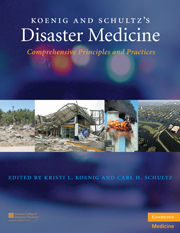Book contents
- Frontmatter
- Contents
- List of Contributors
- Contributor Biographies
- Foreword
- Preface
- Acknowledgments
- PART I CONCEPTUAL FRAMEWORK AND STRATEGIC OVERVIEW
- PART II OPERATIONAL ISSUES
- 9 Public Health and Emergency Management Systems
- 10 Legislative Authorities and Regulatory Issues
- 11 Syndromic Surveillance
- 12 Triage
- 13 Personal Protective Equipment
- 14 Decontamination
- 15 Quarantine
- 16 Mass Dispensing of Antibiotics and Vaccines
- 17 Management of Mass Gatherings
- 18 Transportation Disasters
- 19 Emergency Medical Services Scene Management
- 20 Healthcare Facility Disaster Management
- 21 Mass Fatality Management
- 22 Crisis and Emergency Risk Communication
- 23 Telemedicine and Telehealth Role in Public Health Emergencies
- 24 Complex Public Health Emergencies
- 25 Patient Identification and Tracking
- PART III CLINICAL MANAGEMENT
- Index
- Plate section
- References
12 - Triage
from PART II - OPERATIONAL ISSUES
Published online by Cambridge University Press: 05 August 2011
- Frontmatter
- Contents
- List of Contributors
- Contributor Biographies
- Foreword
- Preface
- Acknowledgments
- PART I CONCEPTUAL FRAMEWORK AND STRATEGIC OVERVIEW
- PART II OPERATIONAL ISSUES
- 9 Public Health and Emergency Management Systems
- 10 Legislative Authorities and Regulatory Issues
- 11 Syndromic Surveillance
- 12 Triage
- 13 Personal Protective Equipment
- 14 Decontamination
- 15 Quarantine
- 16 Mass Dispensing of Antibiotics and Vaccines
- 17 Management of Mass Gatherings
- 18 Transportation Disasters
- 19 Emergency Medical Services Scene Management
- 20 Healthcare Facility Disaster Management
- 21 Mass Fatality Management
- 22 Crisis and Emergency Risk Communication
- 23 Telemedicine and Telehealth Role in Public Health Emergencies
- 24 Complex Public Health Emergencies
- 25 Patient Identification and Tracking
- PART III CLINICAL MANAGEMENT
- Index
- Plate section
- References
Summary
OVERVIEW
Introduction
One of the hallmarks of a disaster is that the immediate needs of the affected population exceed currently available resources. Intuitively, this leads to the question of how limited resources can be used to optimize patient outcomes. Triage is the allocation of limited resources during a disaster. Although the concept of triage is applicable to all resources, the most commonly discussed and most studied application is to patient care. In this context triage is the rapid evaluation of patients to determine the most appropriate level of care and treatment, given the limited resources at hand. For the remainder of this chapter, triage shall refer specifically to identifying the appropriate level of care for patients during a mass casualty incident.
Although researchers have investigated this type of triage more extensively than the triage of equipment or other resources, even patient triage is not well studied. As with many topics encompassed by disaster medical sciences, it is extremely difficult to conduct randomized, controlled trials during an actual event; the use of other comparative study designs is also challenging. As a consequence, there is no high-quality evidence indicating which triage systems provide optimal resource utilization or maximal outcomes, or even whether existing triage systems are of any value in managing the scene, optimizing resource allocation among patients, or ensuring optimum outcomes.
Keywords
- Type
- Chapter
- Information
- Koenig and Schultz's Disaster MedicineComprehensive Principles and Practices, pp. 174 - 183Publisher: Cambridge University PressPrint publication year: 2009
References
- 2
- Cited by



